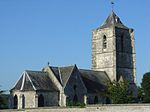Ablain-Saint-Nazaire
ArtoisCommunes of Pas-de-CalaisPages with French IPAPas-de-Calais geography stubsWorld War I stubs

Ablain-Saint-Nazaire (French pronunciation: [ablɛ̃ sɛ̃ nazɛːʁ]) is a commune in the Pas-de-Calais department in northern France.
Excerpt from the Wikipedia article Ablain-Saint-Nazaire (License: CC BY-SA 3.0, Authors, Images).Ablain-Saint-Nazaire
Allée Jules Ferry, Lens
Geographical coordinates (GPS) Address Website Nearby Places Show on map
Geographical coordinates (GPS)
| Latitude | Longitude |
|---|---|
| N 50.3928 ° | E 2.7133 ° |
Address
École primaire
Allée Jules Ferry
62153 Lens
Hauts-de-France, France
Open on Google Maps










